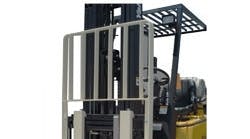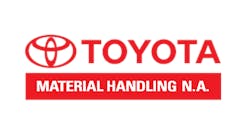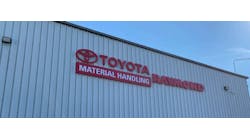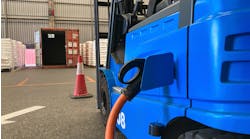An AGV transports a pin cart loaded with acetate-fiber packages to the finished-product production line for packaging.
Towards the end of World War I, a global rawmaterial shortage was forcing American industrialists to search for different ways to get their products to market. It was then that George Eastman, father of modern-day “snapshot” photography and founder of Eastman Kodak Co., established a satellite company to produce wood alcohol for his film products.
The company, dubbed Tennessee Eastman Co., supplied Kodak with raw materials for years. It wasn’t until the 1990s that the company was spun off from Kodak to become Eastman Chemical Co. (Kingsport, Tenn., www. eastman.com).
Today, Eastman Chemical is a global chemical supplier with 2006 sales of $7.5 billion. More than 1,200 chemicals, fibers and plastics – used in the production of consumer packaging materials, furniture and apparel fabric and even everyday house paint – can trace their origins to Eastman.
A portion of Eastman’s 600-acre manufacturing plant adjacent to its headquarters in Kingsport, Tenn., is devoted to producing acetate thread – called “yarn” – and shipping it to cloth manufacturers that use it to make finetouch garments, such as the linings for high-end men’s suits, wedding dresses and evening gowns. Eastman’s acetate-yarn division uses a manufacturing process called “beaming” or “warping” that combines several separate spools of yarn – called “packages” – into one large roll that is then shipped to cloth manufacturers, explains Dan Taylor, project manager at Eastman.
The division uses automated guided vehicles (AGVs) 24 hours a day, seven days a week to transport aluminum pin carts carrying fiber packages from the raw material production area to either a quality lab for inspection or a finished-product production line.
Prior to September 2006, Eastman was having problems with its AGVs. The Kingsport facility was 75 years old, and the flooring, while smooth in some areas, was becoming rougher by the day. And, continual shock and vibration from the uneven floor was damaging sensitive AGV electronics.
“We had a lot of reliability issues,” says Taylor. “We had to assign one full-time operator on all four shifts to follow the five AGVs around. The operator’s sole responsibility was to keep them running.” It was getting ridiculous. “We had as many as 100 interruptions in a 24-hour period,” Taylor adds.
The cure seemed worse than the disease. To upgrade to new AGVs, the company would have to tear up parts of the floor to install new wires and magnets for vehicle guidepaths. In addition, the entire floor would have to be repaired to prevent damage to the new AGVs.
“We would have had to do extensive floor repair that would have actually endangered the business,” says Taylor. That was out of the question.
A Better Way?
So, in the fall of 2005, the procurement department set out to research other AGV vendors. “The best candidate was FMC Technologies,” says Taylor. Over a four-month period, Taylor and his team viewed sample installations at automotive production facilities in Detroit, Pittsburgh and Cleveland. “David Meyrose, FMC sales representative, showed us the company’s AGVs in action,” says Taylor.
One installation really caught Taylor’s eye. “It was a Chrysler facility,” he remembers. “It had a floor made out of six-inch-thick, eight-inch-square compressed wood block. It was a much rougher application than we had at our facility. It looked like a cobblestone street. And, the company was using AGVs to transport large, heavy car parts. That alleviated our worries about having to do floor repair.”
The navigation technology used by the AGVs also impressed Taylor. “The FMC AGVs use laser-guided telemetry that allows for a flexible guidepath that can be changed on the fly,” Taylor says.
FMC also uses chip-to-chip programming, instead of standard disk drives, in its AGV electronics, and
Taylor saw that as another benefit. “We noticed, in our old system, that the moving parts inside of a small disk drive were not very robust,” he says.
Taylor and his project team were convinced. So, by February 2006, Eastman purchased five new fork/ outrigger, laser-guided AGVs from FMC. Each AGV has a load capacity of 1,500 pounds and is capable of transporting 23 loads per hour.
Although the floor didn’t need to be reconstructed, some prep work had to be done to accommodate the new AGVs. “We sent AutoCAD drawings to FMC indicating our existing guidepaths,” he says. “Mark Fung, FMC’s project manager, was instrumental in the success of the project,” adds Taylor. “He helped outline the functional specs. We wanted the vehicles to move, generally, in the same directions, and the pick-up points would stay the same,” Taylor continues. “FMC then used our drawings of the area to write the software code.”
All that preparation paid off. “When the vehicles arrived at the facility, our guidepaths were about 95% complete,” Taylor says. “Even blocking – collision avoidance – was all worked out beforehand. All we had to do was some fine tuning.”
That was important to Eastman, because the company needed seamless transfer to prevent production downtime and work stoppages. “Due to the nature of our business, we had to be able to re-commission the new system as soon as we decommissioned the old one.”
Thanks to the planning meetings between FMC and Eastman, that goal was achieved. Within 48 hours of shutting down the old vehicle system, the new AGVs were processing orders. By September 2006, Taylor says, the vehicles were up and running at full speed.
Coordinated Moves
Today, all automated load movements are directed by FMC’s SGV (self-guided vehicle) Manager software – the “control system” for the AGVs. Each forked AGV communicates with the control system through RF-enabled input/output optical sensors throughout the plant. In addition to dispatching the vehicles, the sensors also detect load and vehicle position.
In the raw material area, an operator places packages on a pin cart and then pushes the cart into a pick slot hard wired for one of two destinations – production or lab. An overhead sensor “detects” the cart and sends a load-movement command to SGV Manager, which then assigns the command to the AGV that can most efficiently complete the task. After being dispatched, the AGV picks up the cart, travels on a pre-designed guidepath and takes it to a lab for sampling or drops the load onto an input conveyor at the finished-product production line.
At the input conveyor, Eastman’s totally automated packaging system (TAPS) interfaces with SGV Manager. The conveyor feeds a Fanuc robotic packaging machine, which unloads the packages from the pin cart, puts them in proper sequence, packages them and applies cardboard and shrink wrap.
Once the finished product is on the output conveyor, another AGV is dispatched to pick up the empty pin cart and transport it back to the raw material area, where the sequence starts again.
“During this process, the AGVs do opportunity charging,” explains Taylor. “From time to time, whenever they are available, they go and get ‘a drink of water’ from charge locations throughout the area. They are smart enough to ‘know’ which charger is closest.”
For navigation and collision avoidance, SICK laser sensors are mounted on top of the AGVs as a beacon device, and reflective strips are placed around the plant. Each vehicle navigates by emitting a rotating laser beam from its onboard beacon. The laser beam strikes the reflective “targets” in the facility and uses calculations to determine the vehicle’s location. The beacon rotates 360 degrees eight times a second, and the AGVs update their position 40 times per second.
“Our old system had mechanical/ microswitch bumpers for collision avoidance,” recalls Taylor. “By the time the AGV stopped, it had already hit the object that should have been avoided.”
Still, flexibility is the benefit Taylor appreciates most. “We can literally redesign the guidepath on the fly,” he says. “If there is a pothole in the floor, we can simply redirect the AGV to go around it until we can patch it.”
Throughput and productivity have improved, thanks to the new AGV system. “Before, we could barely keep up with production with full-time operators walking behind five AGVs,” Taylor says. “We can now run full production with only four AGVs and one sitting on a charger. Basically, we are running production with only four vehicles.”
The new system also reduced labor costs by freeing up employees to work on other valueadded tasks. “We had been continually tying up our maintenance resources to keep vehicles repaired,” says Taylor. Instead of spending time reacting to breakdowns, employees can devote time to improving the overall process. “Because the system runs so well, we are able to see and correct bottlenecks,” Taylor explains.
Today, the Kingsport facility measures interruptions in days instead of hours, and Taylor estimates full payback within three years.
The Human Side
Many lessons can be learned from Eastman’s story. Obviously, choosing a reliable, flexible automated system is key to improving operational efficiency. Still, it’s the human factor that will ultimately make or break an automation project.
“When forming a project team, be sure each craft or discipline is represented,” Taylor recommends. “Include an operational person who can determine production needs, a procurement person to handle the sale, a hardware representative who can understand input/output interfaces and a software expert to understand code. We even pulled in an RF wireless engineer who handled the dispatch system over the RF network and a contractor representative for the installation,” he says.
“There were about six people on the project team,” he adds. “It’s true that you don’t want too many people on a team, but when you hear one or two guys say they are going to handle it all, you may have problems.”



